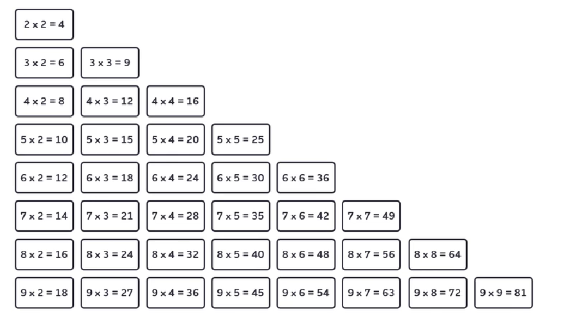Mathematics
At Southbourne Juniors School, our vision is for children to leave as confident, skilled and resilient mathematicians. Our curriculum has been developed to ensure rich connections across mathematical ideas, other curriculum subjects and maths for everyday life, allowing pupils to develop fluency and reasoning.
We aim for pupils to secure the foundations of number sense and place value first as we know that when these basics are secure, children find learning the rest much easier. Concrete and visual representations are embedded in the curriculum, enabling pupils to learn to calculate with confidence and develop a deep understanding of why maths works. Teachers focus on developing pupils’ understanding of mathematical vocabulary and there is an expectation, starting with our youngest children, to communicate and reflect using the language of maths.
Through creative and practical lessons, children appreciate what it means to be a mathematician; they thrive upon conquering the challenges and puzzles that mathematics brings and are not afraid to make mistakes.
Implementation
We follow the National Curriculum for Maths using the NCETM Maths Mastery approach to teaching.
'Maths Mastery’ is used to describe the elements of classroom practice that combine to develop children’s deep and lasting understanding of mathematical procedures and concepts to maximise success with the subject.
Southbourne Junior School is part of the NCETM/Maths Hubs programme. A central component of our engagement with the hub has been discussion around effective teaching for mastery underpinned by Five Big Ideas. These big ideas are supported by research evidence and inform the approach to maths teaching at our school.
Coherence
Teaching is designed to enable a coherent learning progression through the curriculum, providing access for all pupils to develop a deep and connected understanding of mathematics that they can apply in a range of contexts. This is supported by pre and post teaching.
Representation and Structure
Teachers carefully select representations of mathematics to expose mathematical structure. The intention is to support pupils in ‘seeing’ the mathematics, rather than using the representation as a tool to ‘do’ the mathematics. These representations become mental images that pupils can use to think about mathematics, supporting them to achieve a deep understanding of mathematical structures and connections. Practical resources, varied pictorial representations and active maths complement our curriculum.
Mathematical thinking
Mathematical thinking is central to how pupils learn mathematics and includes looking for patterns and relationships, making connections, reasoning, and generalising. We encourage talk within lessons, providing opportunities for pupils to actively engage in mathematical thinking through effective questioning.
Fluency
Efficient, accurate recall of key number facts and procedures is essential for fluency, freeing pupils’ minds to think deeply about concepts and problems, but fluency demands more than this. Within lessons, we provide opportunities for pupils to apply their mathematics and develop flexibility to move between different contexts, to recognise relationships and make connections and to choose appropriate strategies to solve problems.
Variation
The purpose of variation is to draw closer attention to a key feature of a mathematical concept or structure through varying some elements while keeping others constant.
-
Conceptual variation involves varying how a concept is represented to draw attention to critical features. Often more than one representation is required to look at the concept from different perspectives and gain comprehensive knowledge.
-
Procedural variation considers how the student will ‘proceed’ through a learning sequence. Purposeful changes are made in order that pupils’ attention is drawn to key features of the mathematics, scaffolding students’ thinking to enable them to reason logically and make connections.
Arithmetic and Times Tables
In years 3 and 4 we follow the Number Sense Maths Times Tables Fluency programme, at the core of the programme are 36 essential times table facts. The programme focusses on developing understanding and recall of these 36 facts and on using them to know the commutative multiplication facts up to 9 x 9 and the inverse division facts. Later in the programme, in preparation for the Year 4 Multiplication Tables Check, the 11 and 12 times tables are also taught, as well as practice of the 10 times table.

Every child has a Times Tables Rockstars and Numbots account to develop fluency with mental addition and subtraction. Certificates are awarded as pupils increase their rapid recall of facts and we often run tournaments to encourage pupils to practise times tables at home. TTRS login
We follow the NCETM programme of study, supplemented with Gareth Metcalfe and Oak Academy resources to develop Maths Mastery. Please see the overview below for each year group. Teachers have the flexibility to make adaptations to the length of time spent on a unit depending on their year groups’ needs.
‘Good mathematics is not about how many answers you know...It’s how you behave when you don’t.’ (Anonymous)
'I enjoy maths because we play games and don't just write on a sheet, I have challenged myself to try harder questions to become more confident.' Year 6 mathematician
'I have practised using place value charts to help me to accurately solve a range of problems. All of these lessons have helped me improve in capability of more challenging and harder questions.' Year 4 mathematician.
'It is helpful when we start our lessons with a “Can I remember…”, as it is useful for remembering what we have learnt before.' Year 5 mathematician.
'I like the extra things that we use like multiplication tables, multi-link and dienes, they are really accessible. These help us if we don’t understand.' Year 5 mathematician.

